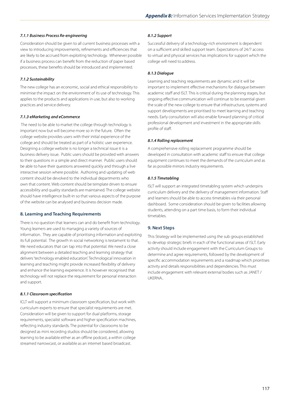
Appendix 8: Information Services Implementation Strategy
117
7.1.1 Business Process Re-engineering
Consideration should be given to all current business processes with a
view to introducing improvements, rei nements and ei ciencies that
are likely to be accrued from exploiting technology. Whenever possible
if a business process can benei t from the reduction of paper based
processes, these benei ts should be introduced and implemented.
7.1.2 Sustainability
The new college has an economic, social and ethical responsibility to
minimise the impact on the environment of its use of technology. This
applies to the products and applications in use, but also to working
practices and service delivery.
7.1.3 eMarketing and eCommerce
The need to be able to market the college through technology is
important now but will become more so in the future. Often the
college website provides users with their initial experience of the
college and should be treated as part of a holistic user experience.
Designing a college website is no longer a technical issue it is a
business delivery issue. Public users should be provided with answers
to their questions in a simple and direct manner. Public users should
be able to have their questions answered quickly and through a live
interactive session where possible. Authoring and updating of web
content should be devolved to the individual departments who
own that content. Web content should be template driven to ensure
accessibility and quality standards are maintained. The college website
should have intelligence built-in so that various aspects of the purpose
of the website can be analysed and business decision made.
8. Learning and Teaching Requirements
There is no question that learners can and do benei t from technology.
Young learners are used to managing a variety of sources of
information. They are capable of prioritising information and exploiting
its full potential. The growth in social networking is testament to that.
We need educators that can tap into that potential. We need a close
alignment between a detailed teaching and learning strategy that
delivers 'technology enabled education'. Technological innovation in
learning and teaching might provide increased l exibility of delivery
and enhance the learning experience. It is however recognised that
technology will not replace the requirement for personal interaction
and support.
8.1.1 Classroom specii cation
ICLT will support a minimum classroom specii cation, but work with
curriculum experts to ensure that specialist requirements are met.
Consideration will be given to support for dual platforms, storage
requirements, specialist software and higher specii cation machines,
rel ecting industry standards. The potential for classrooms to be
designed as mini recording studios should be considered, allowing
learning to be available either as an ol ine podcast, a within college
streamed narrowcast, or available as an internet based broadcast.
8.1.2 Support
Successful delivery of a technology-rich environment is dependent
on a sui cient and skilled support team. Expectations of 24/7 access
to virtual and physical services has implications for support which the
college will need to address.
8.1.3 Dialogue
Learning and teaching requirements are dynamic and it will be
important to implement ef ective mechanisms for dialogue between
academic staf and ISLT. This is critical during the planning stages, but
ongoing ef ective communication will continue to be essential given
the scale of the new college to ensure that infrastructure, systems and
support developments are prioritised to meet learning and teaching
needs. Early consultation will also enable forward planning of critical
professional development and investment in the appropriate skills
proi le of staf .
8.1.4 Rolling replacement
A comprehensive rolling replacement programme should be
developed in consultation with academic staf to ensure that college
equipment continues to meet the demands of the curriculum and as
far as possible mirrors industry requirements.
8.1.5 Timetabling
ISLT will support an integrated timetabling system which underpins
curriculum delivery and the delivery of management information. Staf
and learners should be able to access timetables via their personal
dashboard. Some consideration should be given to facilities allowing
students, attending on a part time basis, to form their individual
timetables.
9. Next Steps
This Strategy will be implemented using the sub groups established
to develop strategic briefs in each of the functional areas of ISLT. Early
activity should include engagement with the Curriculum Groups to
determine and agree requirements, followed by the development of
specii c accommodation requirements and a roadmap which prioritises
activity and details responsibilities and dependencies. This must
include engagement with relevant external bodies such as JANET /
UKERNA..